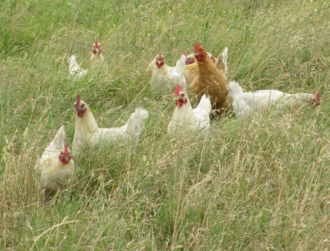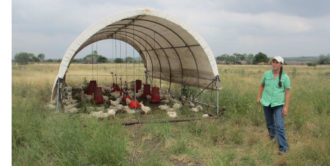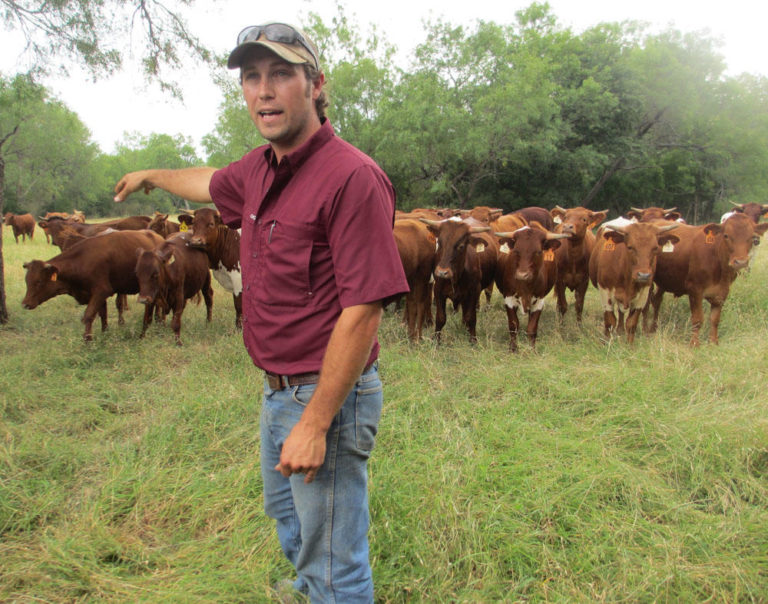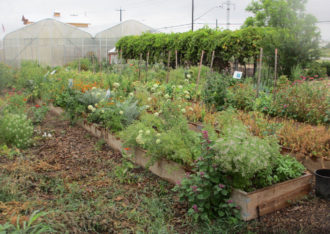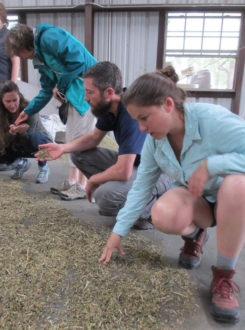D’HANIS, Texas -- Travis Krause lets out a loud cattle call. Within seconds, his herd appears in the distance among the tall grass, brush and trees of the South Texas Plains, and makes a fast trot to where the young farmer is standing. The animals line up side by side as if preparing for a photo op and curiously gaze upon the group of county agricultural educators who have come to visit Parker Creek Ranch on a warm and windy Tuesday afternoon.
Krause explains that the grass-fed cattle, a cross between Devon and Texas Longhorn, are the newest additions to his and his wife’s farm, which has been in the family since it was established in 1846. Once a conventional cow-calf ranch, the young couple are striving for a more sustainable operation, using holistic management techniques in consort with wildlife conservation and ecosystem practices that they hope will not only maintain their quality of life and make for a profitable farm, but will also preserve the land for their two-year-old son, his children and beyond.
“We believe that sustainable agriculture bridges the gap between livestock management and wildlife conservation,” said Mandy Krause. “We are trying to get people to reconnect to the land through food, while also caring for the land that nourishes us. We hope to become an incubator in the local region to help other farmers take notice that sustainable ag practices do work. It’s been challenging, but a wonderful, fulfilling process.”
The county educators visiting Parker Creek Ranch were part of the Sustainable Agriculture Research and Education (SARE)/National Association of County Agricultural Agents (NACAA) Fellows Tour – a program that provides county agents from across the country the opportunity to experience sustainable agriculture outside of their region.
“If I had to pick an enjoyable experience from the trip, it would be learning from other participants at each stop, especially at operations that are out of my area of expertise,” said Stacey Bealmear-Jones, a nursery and greenhouse county agent at North Carolina State University Cooperative Extension. “Livestock is a great example of this. I’m a horticulture agent, so I don’t know much about animal production. Listening to others talk to producers and ask questions makes me think about aspects of farming and business I never considered. Someone in the group always has an interesting perspective that allows for more discussion as we ride along to our next stop.”
Every two years, the SARE Fellows Tour makes its way to the Southern region. This year Texas made the list, hosted by SSARE state ag coordinator Diane Boellstorff and SSARE program assistant John Smith, both with Texas A&M University; and Nelson Daniels, SSARE state ag co-coordinator with Prairie View A&M University.
Covering three ecoregions and the diverse agriculture of each one, the SARE Fellows group visited organic farms, farmers’ markets, food banks, seed production operations, orchards, meat packaging plants, and non-profits.
“Throughout the country we are unified in our challenges in producing food in an environmentally responsible way that also allows for farm profitability,” said Olivia Saunders, a food and agriculture field specialist with University of New Hampshire Cooperative Extension. “Just as farmers in my region are creative in how they manage to make ends meet, I saw producers in Texas developing creative enterprises to fit the demands of a modern agriculture system.”
With agriculture serving the heavily populated areas of San Antonio, Austin and Dallas-Fort Worth, there is a tremendous interest in urban farming and sustainable agriculture, said Todd Swift, Texas A&M AgriLife Extension regional program leader. One recurring theme during the tour was water, and the challenges Texas farmers face in both quality and quantity.
“High quality and adequate supplies of water are essential to sustainable agriculture producers for enterprise profitability, and for the health of their families, workers and supporting ecosystems,” said Diane Boellstorff. “From the arid areas of Texas where impaired water quality and reduce water availability have long been recognized as significant challenges and obstacles to successful sustainable agriculture, to the more humid east and coastal areas of Texas, each farmer and rancher on the tour emphasized the importance of both water quanity and quality.”
Major stops included the San Antonio Food Bank, complete with fields of Texas A&M University vegetable trials, an educational garden, and aquaponics/hydroponics system; Studebaker Farms, where the use of hoop houses for peach production brings fruit to market 4-5 weeks earlier than field production; Wildseed Farms, the largest working wildflower farm in the country; Johnson’s Backyard Garden, whose organic vegetables serve the Austin community; and Coyote Creek Farm, a rare organic feedmill that helps serve Texas livestock operations.
“Although I was familiar with Wildseed, I did take lots of notes and think about ways that smaller scale producers could adopt some of the seed harvesting, processing and storage techniques used to offer a local provenance of wildflower and native grass seeds,” said Laura Miller, a commercial horticulture agent for Texas A&M AgriLife Extension. “It kind of seems like the ultimate in sustainability and hits some of the more timely concerns, including pollinator habitat protection.”
Back at Parker Creek Ranch, the 100 head of cattle clustered around Travis appear to finally get bored of the spectacle and move on, one by one into the brush. That prompted the SARE Fellows group to move on to other parts of the farm, which included pastured poultry along with laying hen mobile shelters, and a broiler hen operation with an on-site broiler processing facility.
“We believe that small-scale, regenerative farming methods can be very beneficial for the wildlife, livestock and people,” said Mandy Krause. “Mob-grazing, multi-species grazing, native plantings, sub-soiling, and prescribed fires are all methods we implement to achieve our goal of environmental stewardship. Our primary goal is the health of the land.”
The SARE Fellows group had the opportunity to conduct a “Reading the Farm” analysis of Parker Creek Ranch – a training tool that brings together educators and experts to share knowledge and insights in the context of working, real-world farms.
“The Reading the Farm experience reinforced for me the importance of having interdisciplinary Extension teams to ensure a breadth of expertise and perspectives in assessing a farm operation holistically,” said Michael O’Donnell, an organic and diversified ag educator with Purdue University. “We all bring biases and a limited set of expertise, so bringing in a diverse range of educators, specialists, and staff from partnering agencies allows for a more critical, holistic assessment of a farm operation and to develop sound, practical feedback for the farm to enhance sustainability of its operation.”
Troy Salzer, an ag production systems Extension educator with University of Minnesota, sees the various facets of implementing sustainable agriculture on the farm as a journey, much like the one Travis and Mandy Krause are currently on. Krause recalls the day he convinced his parents that there was room on the long-standing conventional farm for more sustainable methods.
“I came home from the farmers’ market one Sunday with $4,000 in my pocket. I made it a point to count it out on the kitchen table,” said Krause. “My father never said another word after that.”
Other participants on the SARE Fellows Tour included James Jones, an ag economist with Oklahoma State University; Crystal Stewart, an Extension vegetable specialist with Cornell University; and David Redhage, SSARE’s Professional Development Program manager with the Kerr Center for Sustainable Agriculture.
The next SARE Fellows Tour will take place this fall in North Dakota.
For more information on how to apply for the SARE/NACAA Fellow Program, visit https://www.sare.org/Professional-Development/Fellows-Program.
Published by the Southern Region of the Sustainable Agriculture Research and Education (SARE) program. Funded by the USDA National Institute of Food and Agriculture (NIFA), Southern SARE operates under cooperative agreements with the University of Georgia, Fort Valley State University, and the Kerr Center for Sustainable Agriculture to offer competitive grants to advance sustainable agriculture in America's Southern region. USDA is an equal opportunity employer and service provider. Any opinions, findings, conclusions, or recommendations expressed in this publication are those of the author(s) and do not necessarily reflect the view of the U.S. Department of Agriculture.
